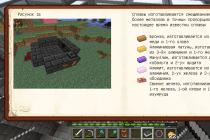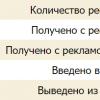Aksakov Historical and Cultural Center "Nadezhdino"
The village of Nadezhdino is the ancestral home of the Aksakov family. Back in the 60s. In the 18th century, the husband of S.T. Aksakov’s great-aunt, M.M. Kuroyedov, “bought about 20 thousand black soil from the Bashkirs in the tracts ...”, brought here serfs from the Simbirsk province and founded the village, naming it after his wife - Hope. Mikhail Maksimovich Kuroyedov built a stone church and a manor house here.
After the death of great-aunt S.T. Aksakov N.I. Kuroyedova, the village of Nadezhdino passed into the possession of the writer's father, Timofey Stepanovich. In 1821, he allocated the Nadezhdino estate to Sergei Timofeevich for living in it with his family and under the full care of the owner.

After the death of Sergei Timofeevich in 1859, his son Grigory Sergeevich inherited his estate, and since 1892, "the heirs of the hereditary nobleman G.S. Aksakov - Sergei Grigorievich and the maiden Olga Grigorievna Aksakov" were recognized as the owners of the Nadezhdinskaya estate and nearby lands.
Olga was the favorite granddaughter of the writer, he dedicated his "Childhood of Bagrov-grandson" to her. She sacredly guarded the memory and the entire archive of the richly gifted Aksakov family.

Olga Grigorievna tried, as best she could, to prolong the life of the Aksakov estate in Nadezhdino and opened a koumiss clinic for tuberculosis patients on the lands that belonged to her behind the railway. Now it is a sanatorium named after S.T. Aksakov.
The church in the name of the Holy Great Martyr Demetrius of Thessalonica was built by M.M. Kuroyedov in 1799. At the temple in the house built by G.S. Aksakov, in 1879 a parochial school was opened. The church operated until the 30sXXcentury. Then it was closed and given over to the granary. In the 70s, the warehouse was liquidated and the church building, which turned out to be ownerless, was gradually destroyed.

By the 200th anniversary of S.Taksakov, the temple was restored by the Government of the Republic of Bashkortostan. The President of the Fund of Slavic Literature and Culture V.M. Klykov donated to the church a temple icon of Dm.
The restored white-stone temple and the recreated house of the Aksakov family are visible from afar. I would like to quickly come to where the soul rests, where time has stopped, and plunge into the historical era.
The village of Nadezhdino is inextricably linked with the name of the remarkable Russian writer of the 19th century Sergei Timofeevich Aksakov and his sons - Ivan and Konstantin, poets, publicists, public figures and writers, Grigory - the Ufa governor and his daughter Olga Grigorievna Aksakova.
On September 28, 2002, by the Decree of the President of the Republic of Bashkortostan, the Aksakov Historical and Cultural Center "Selo Nadezhdino" was opened here. The basis of the center was the Dmitrievsky temple and the restored manor house of the writer, in which the Museum of the Aksakov family was opened.
Today, the Aksakov Historical and Cultural Center hosts the traditional folk holidays Christmas and Maslenitsa, the Days of Slavic Literature and Culture, and the International Aksakov Holiday.
The administration of the municipal district Belebeevsky district of the Republic of Bashkortostan, with the participation of the Ministry of Culture and National Policy of the Republic of Belarus, the Aksakov Fund, is building schools of folk crafts.
An important historical and cultural object of the center is the House-Museum of the Aksakov family. The museum consists of four exhibition halls, each of which is dedicated to solving specific educational problems.
LEDITIONS OF THE OLD DEEP. PINK LIVING ROOM

This hall is dedicated to the 19th century and shows the perception of the surrounding world and, in a way, through the eyes of young Seryozha. In his family history, two powerful poles of social life of the 18th century are intertwined - unlimited power, reaching tyranny in the person of M.M. Kuroyedov, and the spiritual power of strong moral natures - creators in the person of grandfather Stepan Mikhailovich Aksakov.
There is a beautiful legend that Aksakov's ancestor Shmon, and at baptism named Simon, left in 1027 to the Grand Duke Yaroslav Vladimirovich in Kyiv from the Varangian family. But it is documented that the Aksakovs went from the thousandth Ivan Kalyata, Ivan Aksak (so called for lameness, because “aksak” in translation from the Turkic languages means “lame”), the son of Velyamin, who left the Golden Horde under Khan Uzbek.
FAMILY IDYLL

The hall is dedicated to the 20s of the 19th century. This is a small room, the beauty and unusualness of which is given by high windows-doors overlooking a bright, cozy terrace.
Sergei Timofeevich in 1821 settled in Nadezhdino with his family. Here they read aloud and from memory a lot, arranged children's costume holidays. Favorite reading in the family were books on the history of the Russian state, the Roman Empire, biblical stories.
This room presents a women's table with an old handicraft box, samples of embroidery from ladies' albums and frames with herbariums.
In the corner is a huge easy chair and a cozy footstool. It seems that Sergei Timofeevich just got up from it and went out for a minute.
Memories of the estate

This hall is located in the center of the house and all expositions represent a collective image of the estate.
The exposition presents portraits of the famous sons of the writer: Konstantin and Ivan, a large portrait of Sergei Timofeevich (works by N. Kupriyanov). In showcases - books, scientific works of Konstantin Sergeevich and Ivan Sergeevich.
Ivan Sergeevich Aksakov, the youngest son of the writer, who later became a well-known public figure, writer, publicist, Slavophile, was born in Nadezhdino in 1923. He was baptized in the Dmitrievsky Church.
THE LAST OWNERS OF THE ESTATE. LARGE LIVING ROOM.

The hall is dedicated to the middle son of the writer Grigory Sergeevich and granddaughter Olga Grigorievna Aksakov.
After the death of S.T. Aksakov in 1859, the estate was inherited by his son Grigory Sergeevich. From 1861 to 1867 he was a civilian governor in Ufa.
In 1867 he was appointed governor of Samara. In 1982, after the death of his father, Grigory Sergeyevich, Sergey Grigoryevich and Olga Grigorievna became the owners of the Nadezhdinskaya estate and nearby lands.
This room presents a large number of photographs of the descendants of the Aksakov family. In the center is a walnut furniture set for 12 items, donated by Aksakov's relative V.Yu. Matveev.
International Aksakov holiday
Traditionally, every year in September, the International Aksakov Holiday takes place, in which all the inhabitants of the "blessed land" take part.
A real festivities are unfolding on Aksakov Street. Improvised national courtyards with traditional cuisine, arts and crafts are being designed. The national flavor is present in welcome songs and treats, in folk dances and simple communication between participants and guests and spectators. And everything merges into a single round dance of Friendship.
Next, the action moves to the estate. Here guests are greeted by folk art groups with laudatory songs and, accompanied by Nastenka, they go to the Dmitrievsky temple along an impromptu corridor of the young generation of Aksakovites.
After the service in the temple, the guests proceed to the Museum of the Aksakov family. Participants of the holiday visit the music salon and plunge into the fairy tale "The Scarlet Flower".
By tradition, holiday guests plant linden, arborvitae, chestnut, cedar, mountain ash trees. And in a few years, the park will rustle in the estate in memory of the great Aksakov family.
First published: The history of my acquaintance with Gogol, including all correspondence from 1832 to 1852. Op. S. T. Aksakova. <Под ред. Н. М. Павлова> AND Russian Archive. 1890. Book. 4. No. 8.
pp. 39-40. Published according to a copy of S. T. Aksakov in his History of our acquaintance with Gogol, including all correspondence from 1832 to 1852.<с 1832 по 1843 г.>»: RSL. F. 3. K. 6. Unit. ridge 1.
Your Lisa ... writes herself.- Gogol's sister E. V. Gogol, Ph.D. 302 who lived in the house of P.I. Raevskaya. Apparently, a letter from Elisaveta Vasilievna to her brother was attached to S. T. Aksakov's letter (see commentary to letter No. 480).
S. T. Aksakov
First printed, (with inaccuracies and omissions: <Ку- лиш П. А.>Nicholas M. Notes on the life of N. V. Gogol. SPb., 1856.
T. 1. S. 260; more complete, but also with inaccuracies and omissions printed: Letters of N. V. Gogol): Ed. V. I. Shenrok. SPb.,<1901 >. T. 2.
pp. 58-60. Autograph printed: GLM. F. 67. Op. 1. D. 3. 2 l.
... I still hope to stay in Vienna for a month and a half ... - See comment. to letter no. 482.
... "What will you give us new ones?" ... - S. T. Aksakov zoz minal, as in the autumn of 1839, upon Gogol’s arrival in Moscow, “Konstantin asked Gogol a question, the most natural, but, of course, too often repeated by everyone when meeting with the writer: “What did you bring us, Nikolai Vasilyevich?”, - and Gogol suddenly, very dryly and with displeasure, he answered: "Nothing." Such questions were always very unpleasant to him; he especially liked to keep a secret
what he was doing, and could not stand it if they wanted to violate it ”(Gogol in the memoirs of his contemporaries. P. 99).
Qing(Tsynsky) - Lev Mikhailovich, Moscow chief of police in 1834-1845.
Konstantin Sergeevich - Aksakov.
kstr.304... was my Shakespeare found, the 2nd volume, which was taken by him
with you... - This, in all likelihood, refers to the edition in French, which Gogol mentioned in a letter to A. S. Danilevsky dated April 23 (N.S.) 1838: volumes of Shakespeare, that edition, which is in two columns and in two volumes, I think, and in these shops in the Paleroyal, one can very easily find him. If there had been Noel, he would have fulfilled this commission gloriously. You can give up to 10 francs for it, because I gave 13 francs for both volumes.<ков>"(Letter No. 356).
... both editions of Maksimovich's songs ... -"Little Russian songs published M. Maksimovich.(M., 1827); "Ukrainian folk songs published by M. Maksimovich" (M., 1834. Part 1).
Mikhail Semenovich- Shchepkin.
...all the boots made for me by Take... - About the Moscow shoemaker Take, see the commentary to the lines of the seventh chapter of the first volume of "Dead Souls" - ...big...boot hunter...- in vol. 5 present. ed.
my comrade- V. A. Panov.
E. V. Gogol
The date of the letter has been corrected. It was most likely written in Vienna, where Gogol was expecting a letter from his sister (see letter to her dated June 25 (N.S.); letter No. 473) and where on July 5 (N.S.) 1840 he received a letter from Moscow from S. T. Aksakov. In this letter, Aksakov informed Gogol that his sister was also writing a letter to him, which was probably attached to Aksakov's message: “Your Liza is healthy, she is starting to get used to her new life and is getting along well. We see each other often. She stays with us another day: yesterday was Sunday, and today Raevskaya is not at home. Lisa writes herself” (letter No. 478). A month later, in a letter to his mother dated August 7 (N.S.) 1840 from Vienna, Gogol mentions the letters he receives from his sister in Moscow. In the same place, Gogol talks about the message of his sister (in her letter to her mother) about the illness that happened to Elizabeth after parting with Gogol on May 18, 1840: “... out of her recklessness, she wrote a letter at that very moment, and added to this chest pain, which is naturally a lie. Because I received a letter from Aksakov that very minute that she had grown fat. Yes, and she herself writes to me that, despite her grief, she is getting fat and is extremely afraid of becoming Shchepkin, and all the dresses had to be transported to her. That's the kind of chest pain she has!" (Letter No. 482). (Apparently, citing Aksakov's "evidence" in the letter that his sister had "gone fat," Gogol was thus "retelling
says a short Aksakov message that "Lisa ... is healthy.") In turn, in a letter to Elisaveta herself, Gogol writes about her illness: "You are very suspicious when it comes to your own health." (Later, in a letter to his sister dated September 10 (N.S.) 1840, Gogol reprimands her: “Why did you write that you fell off the droshky, that your chest has been hurting since then, that you miss terribly”; letter N ° 484.) Thus, the letter from the sister was apparently received by Gogol on July 5 (N.S.), 1840, along with the letter from S. T. Aksakov; and the answer, in turn, was enclosed, as one might suppose, in a letter to Aksakov dated July 7 (N.S.), 1840.
Molchanova - Sofia Nikolaevna.
A. A. Ivanov - N. V. Gogol
First published, with inaccuracies and without reference to Gogol: Alexander Andreevich Ivanov. His life and correspondence. 1806- 1858. Published by Mikhail Botkin. SPb., 1880. S. 125-126. Published according to: Correspondence of N. V. Gogol. In 2 volumes. Entry. Art. A. A. Karpova. Comp. and comment. A. A. Karpova and M. N. Virolainen. M., 1988. T. 2. S. 444-445; with an addition by: Alexander Andreevich Ivanov (1806-1858).
Letters and notebooks. Compilation, foreword and note.
B. M. Bernstein AND Masters of Art about Art. M., 1969. T. 6.
S. 301. to page 305
... arranged in the form of offices ... - Further in a 1969 publication:
"very tightly closed." to page goiter
...in Overbeck's studio his big picture...- Painting by F. Overbeck "The Union of Religion with the Arts" (finished in 1840).
...in Ingres's studio his painting... - It means either the painting by J. Ingres "Odalisque and the Slave", or his "Stratonic".
M. I. Gogol
I stay here no more than a week and go to Venice. - A month before, on July 7 (N.S.) 1840, Gogol wrote to S. T. Aksakov: “... I still hope to stay in Vienna for a month and a half ...” In a letter to his sister, A. V. Gogol from On August 7 (N.S.), 1840, he also reported: “I am leaving the other day from here to Venice." However, Gogol arrived in Venice only on September 2 (N.S.) 1840. The reason for the delay was illness. On November 9/21, 1840, V. A. Panov wrote to S. T. Aksakov: “In Vienna, he was worried only by some kind of pain in his leg. During the almost 4 weeks that I stayed here with him, I saw clearly that he was busy with something. Although at that time he was treating himself, drinking water, walking, he still had free time, and then he reread and rewrote his huge collection of Little Russian songs, collected shreds on which he had written down sayings, remarks, etc. Parting about half of June [ac. Art.], we appointed to come together in Venice. He wanted to come
there from Vienna in mid-August, and I was appointed the last date of September 1. Entering Venice on 2 September<бря>, I trembled, I was afraid that he would no longer be found in her. Instead, I meet him at St. Mark's Square and find out that we entered from opposite directions at the same hour. An illness from which he thought he would die delayed him in Vienna. Fortunately, he was with<Н. П.>Botkin, brother of the one whom Konstantin Sergeevich knows. This truly kind person looked after him like a nurse. [He came here with him, and now lives with me in the same house.] This illness upset Nick for a long time<олая>You<ильевича>, without that already upset. She diverted his attention from everything, and only in Venice did he sometimes see moments of calm, in which his spirit somehow enlightened the terrible gloom of his condition, mostly by the necessity of the material ”(Letters of N.V. Gogol / Ed. V. And Shenrock, vol. 2, p. 87). See also letter Nq 490.
Praskovya Ivanovna - Raevskaya.
...attached and chest pain, which is naturally a lie.- See comment to letter no. 480.
E. V. Gogol
The dating of this letter, as well as related letters No. 485-487, has been clarified. The year set by Gogol in a letter to his sister: “1840”, as well as the place of departure indicated in three letters: “Venice”, indicate that the letters could only be written during his stay in Venice from 2 to the beginning of the twenties September (N.S.) 1840 August, these September letters were marked by Gogol erroneously; a similar error is often found in his correspondence and is associated with an incorrect understanding of the calendar when recalculating the difference between the European and Russian styles of chronology (see, in particular, the commentary to letters No. 378, 419, etc.). The dating of these letters by September (10th of the New Style), and not by August, as in Gogol, was proposed at the time by A.I. Kirpichnikov (see: Kirpichnikov A. I. Doubts and contradictions in the biography of N. V. Gogol AND Izvestia ORyaS. 1900. Part 2. p. 46-49). Arguments of A. G. Dementiev, who did not agree with this dating (see commentary, in the ed.: Gogol N.V. Poly. coll. Op.: In 14 volumes.<Л.>, 1952. T. 11. S. 437), seem unconvincing to us. The intention reported by Gogol at the end of this letter to his sister: to be in Rome “at the end of this month”, is exactly fulfilled (based on the proposed dating) with Gogol’s arrival in Rome on September 25 (NS) 1840. Gogol’s message in the same letter about his health: “It was definitely bad, and I fell ill in earnest,” corresponds to the data on his illness in Vienna, from which he left at the end of August (N.S.) 1840 (see commentary , to letter No. 482). Then Gogol served as a means of healing from an illness, according to his own testimony, it was the move - from Vienna to Tri-
eats (near Venice) and further - to Venice and Rome: “I ordered myself to be put on a stagecoach and taken to Italy. When I got to Trieste, I felt better. The road, my only medicine, had its effect this time too” (letter to M.P. Pogodin dated October 29 (N.S.) 1840 from Rome - N ° 490). All this contradicts attempts to attribute the letters written by Gogol in Venice to the time of his stay in Vienna - especially since then it is difficult to give convincing reasons to “the question of why Gogol indicated Venice instead of Vienna” (Gogol N.V. Full coll. cit.: In 14 vols. T. 11. S. 437).
I'm now looking forward to your description of the village...-ext.309 E. V. Gogol, together with P. I. Raevskaya, S. N. Molchanova, N. Zederholm and V. Mosolova, spent the summer of 1840 in the village of Raevskaya (see Gogol’s letter to P. I. Raevskaya dated June 25 (N.S.) 1840 - N ° 477).
Sofia Nikolaevna - Molchanov (see commentary to letter no. 467).
Nadezhda Karlovna- Zederholm.
Olga Nikolaevna- typo; above, Gogol correctly calls the name of Sofya Nikolaevna Molchanova.
Varinka- Mosolova (born 1828), niece of P. I. Raevkstr. 312
M. S. Shchepkin
It is printed with a correction in meaning, in the phrase: “More. I didn’t have time to correct Shakespeare’s play in a hurry,” instead of the erroneous one: “I didn’t manage to correct Shakespeare’s play in a hurry.”
See the comment to the section “Translations edited by N. V. Gogol. Plays for benefit performances by M. S. Shchepkin ”in vol. 7 of the present, ed., as well as lines in Gogol’s letter to A. S. Danilevsky dated April 23 (n. St.) 1838:
"Will you still find the first volume of Shakespeare somewhere..."
(Letter N° 356).
...half the bet won...- See the comment to the section “Translations edited by N. V. Gogol. Plays for benefit performances by M. S. Shchepkin ”in vol. 7 present. ed.
...the comedy is ready.- Russian translation, edited by Gogol, of the comedy "An Uncle in a Difficult Position" by J. Giraud
(vol. 7 present ed.).
S. T. - Sergei Timofeevich Aksakov. to page h 12
Shakespeare's play, I did not have time to correct in a hurry. - See com. 314 ment, to the section “Translations edited by N. V. Gogol. Plays for benefit performances by M. S. Shchepkin ”in vol. 7 present. ed.
O. Sem. Aksakova
The dating of the letter has been corrected (see comment to letter N° 484).
... Sergei Timofeevich is now probably not in Moscow.- S. T. Aksakov recalled this time: “... I informed Gogol,
that I was leaving with Konstantin for the Volga, where I left, it seems, on June 27 ... I returned from behind the Volga at the end of August ”(Gogol in the memoirs of contemporaries. P. 127-128).
... hand over to Mikhail Semenovich the attached action of the comedy translated for him. -
This request applies directly to Vera Sergeevna ... - S. T. Aksakov explained: “The request to Verochka refers to my portrait, which she promised to paint for Gogol, the execution of which, no doubt, was hindered by my absence” (Gogol in the memoirs of contemporaries. P. 128).
M. P. and E. V. Pogodin
The dating of the letter has been corrected (see comment to letter N° 484). kstr.315... give Shchepkin the attached action to the translated
comedy for him. - See commentary to letter N° 485.
Peter- son of MP Pogodin, born in 1840, shortly after Gogol's departure from Moscow.
Mitya - Dmitry Mikhailovich (1836-1859), son of the Pogodins, to page 316Liz<авета>Fominishna - Wagner, Pogodin's mother-in-law.
Agraf<ена>Mikhailovna- Pogodin, Pogodin's mother.
Grigory Petrovich- Pogodin, brother of M.P. Pogodin.
Mikhail Ivanovich- relative of the Pogodins.
Agrafena Petrovna- sister of M.P. Pogodin (married Messing).
Rialto bridge in Venice.
M. I. Gogol
Together with N. P. Botkin and V. A. Panov, Gogol arrived in Rome on September 13/25 (N.S.) 1840.
A. V. Gogol
kstr. 318... as the Savior Himself said, do not look at people. - Probably,
meaning the words of the Savior: “Woe to you when all people speak well of you” (Luke 6:26).
Godson- nephew of N. P. Trushkovsky.
M. P. Pogodin
The date of the letter has been corrected. Pogodin answered this letter to Gogol on November 28, 1840 (letter N° 493). Gogol's letter was received by him in Moscow on November 27, 1840, about which an entry was preserved in his diary: "November... 27... Received a letter from Gogol. He was comforted and upset. Amazing creature man! - And still not quite believable. Man is corrupted, the original mind is clear. - There were moments of solemnity " (Pogodin M.P. Diary. 1840-1845; RSL.
F. 231. Sec. I. K. 33. Unit. ridge 1. L. 19v.). On November 28, 1840, Pogodin wrote an answer (see Letter No. 494). Apparently, the date set by Gogol on the letter: "October 17" refers to the Russian style, because only in this case the time it took for it to reach Moscow (20 days) would be quite real. If, however, we assume that the letter is dated in the new style, that is, written on October 5/17, then the period of its stay in transit will be more than a month, which seems less plausible.
Lisa- Elizaveta Vasilievna, Gogol's sister. kstr 321
...rare finds made by you. - On August 28, M.P. Pogodin purchased manuscripts and early printed books from the collection of the merchant Laptev for the Ancient Storage.
...which lies closest to me... - Perhaps we are talking about the "Chronicle of the Little Russian", with the discovery of which M.A. Maksimovich congratulated M.P. Pogodin at that time.
The plot which lately I have lazily kept in my head svokstr. 322 to her... - A drama from the era of Bogdan Khmelnitsky (see Vol. 7 of this edition).
... terrible anxiety, in which I saw poor Velegorskyex.323in the last moments of life. - O. Sem. Aksakova, responding to these lines of Gogol, wrote to M. P. Pogodin: “Gogol’s letter completely covered me with fog. He must be pulled out of Rome. He himself does not understand, he needs native air - Russian, Moscow friends, and he will come to life, otherwise he will die, like Vielgorsky, like Stankevich " (Barsukov N. Life and works of MP Pogodin. Book. 5. S. 369).
... a place at Krivtsov. - Gogol was busy about the post of secretary. 324 container under P. I. Krivtsov, appointed head of Russian artists in Rome. In return for this, Krivtsov offered Gogol the position of "a librarian of a library that does not yet exist"
No. 522). See also letters N© 452, 464, 476, 492, 494.
... against ... all sorts of different tares ... - See comment, to line. 325 stone of Gogol's notebook 1846-1850. - ... the sting of satire touched ... and what should be sacred ... - in t. 9 present. ed.
...immortal dome... - Dome of St. Peter's Cathedral in Rome.
... as if Zhukovsky is getting married? - In 1841, V. A. Zhukovsky, at the age of 58, married the young Elizaveta Reitern, daughter of the German artist R. Reitern.
E. V. Pogodina
The date of the letter has been corrected. The letter was probably enclosed in a message to M.P. Pogodin dated October 29 (new style), 1840 (see commentary to this letter - No. 490).
You also thank me, Elizaveta Vasilievna, for remembering you. - See Letter No. 487.
P. A. Pletnev
to page 327 ...as my business.- Gogol means the position of the secretary at
P. I. Krivtsov (see commentary to letters N° 452, 464, 476, 490, 494).
I got sick severely... - See commentary to letter N° 482, and also letter N° 490.
Veturin(vetturino; it) - cab.
I started such a thing... - This refers to a drama from Ukrainian history (see comment to<Наброскам и материалам драмы из эпохи Богдана Хмельницкого>in vol. 7 present. ed.).
The Aksakov family is a remarkable, in its own way, unique phenomenon in Russian life in the 1830s-1850s. A noticeable mark in the history of our culture was left by the head of the family - the writer Sergei Timofeevich Aksakov (1791-1859); his eldest son Konstantin Sergeevich (1817-1860) gained fame as a poet, critic and publicist, one of the leaders of early Slavophilism; Ivan Sergeevich Aksakov (1823-1886) was also a prominent poet and public figure. However, the large Aksakov family is remarkable not only for the activities of these most prominent representatives. Contemporaries were attracted by the warmth and cordiality that reigned in her, the purity of her moral atmosphere, the breadth of cultural interests, and the surprisingly strong connection between the older and younger generations [Annenkova, 1983, p. 14.].
In the Aksakovs' house - one of the centers of Moscow life of that era - Gogol was first introduced by M.P. Pogodin in July 1832. Over time, friendly relations connected the writer with many members of this family, but Konstantin Sergeevich and, in particular, Sergei Timofeevich Aksakovs, turned out to be closest to him. By the time of acquaintance with Gogol S.T. Aksakov already occupied a prominent position in the literary and theatrical world of Moscow. From 1827 he served as a censor, and then as chairman of the Moscow Censorship Committee (he was dismissed in February 1832) [Ibid., p. 47]. Having made his debut in print as early as 1812, he subsequently became known as a theater critic, a poet, and was famous as an excellent reciter and authoritative literary judge. However, the heyday of Aksakov the artist was the last one and a half decades of his life, when works were created that determined the writer's contribution to Russian literature - "Notes on the fishing of fish", "Notes of a rifle hunter of the Orenburg province", "Family Chronicle", "Childhood of Bagrov -grandson, etc. The literary situation of the 1840s - a situation that was largely formed under the influence of Gogol's creativity - allowed Aksakov's realistic talent to be fully revealed. Moreover, the attention of Gogol, who was very interested in the literary activity of Sergei Timofeevich, played the role of a direct impetus in the awakening of his writing gift. Having managed to get acquainted with only a part of the works of S.T. Aksakov, Gogol highly valued him as an expert on Russian nature and life, and while working on the second volume of Dead Souls, in turn, he was influenced by Aksakov the prose writer [Gogol, 1951. p. 17].
Gogol's interest in the literary pursuits of members of the Aksakov family was also manifested in his attention to the poetic experiments of I.S. Aksakov, to the artistic, critical, scientific works of K.S. Aksakov, whose talent the writer highly appreciated.
A genuine cult of Gogol the artist reigned in the Aksakovs' house. However, their personal rapprochement with the writer was not easy. Family Aksakov's ardor more than once ran into the restraint, and sometimes the secrecy of Gogol, whose behavior seemed to Aksakov sometimes strange and even insincere. On the other hand, the writer himself was often embarrassed by the categorical assessments characteristic of Sergei Timofeevich - and especially Konstantin Sergeyevich - categorical assessments, intemperance in manifestations of both love and condemnation. Only in 1839 - on Gogol's next visit to Moscow - was a genuine closeness established in his relations with the Aksakovs. “From that very time,” Sergey Timofeevich recalled, “a close friendship began, which suddenly developed between us” [Aksakov, 1956, p. 20].
In the Aksakovs, Gogol found true friends who more than once provided him with various practical assistance, ardent supporters and attentive interpreters of his work. If the bright talent of the writer was discovered for them by “Evenings on a farm near Dikanka”, then the appearance of the collection “Mirgorod” made the Aksakov family look at Gogol as “a great artist with deep and important meaning” [Aksakov, 1956, p. 13]. An even stronger impression was made by "Dead Souls", with the chapters of which the author introduced the Aksakovs, among other selected listeners, even before the publication of the poem. Gogol's work was perceived in the Aksakov family as an unprecedented literary phenomenon, the true meaning of which, due to its vastness, cannot be immediately comprehended by readers. An attempt to explain the essence and meaning of the work was the famous brochure by K.S. Aksakov "A few words about Gogol's poem "The Adventures of Chichikov, or Dead Souls" (1842). Deliberately leaving aside the question of the specific content of the poem, its satirical pathos, the author of the pamphlet brought to the fore the consideration of Gogol's inherent way of depicting reality. According to Aksakov, "Dead Souls" oppose all contemporary art in this respect. In them, as it were, the ancient epic contemplation is resurrected - a broad, complete and impartial image of life. In this regard, Gogol himself - the creator of the modern epic - typologically approached Homer in the brochure. To characterize the Slavophile position of K.S. Aksakov, it is important that the very possibility of the resurrection of epic contemplation in Russia was considered by him as connected with the specifics of Russian national life, the exclusivity of the Russian people. The attitude of the critic towards the creator of Dead Souls clearly revealed the assumption expressed in the pamphlet that the “mystery” of Russian life would be revealed in a fully realized poem, its essence would be revealed [Aksakov, 1982. p. 141].
The appearance of "A few words ..." caused a noisy response from contemporaries. The most fundamental was the speech of V.G. Belinsky - in the recent past, a comrade of Konstantin Sergeevich in Stankevich's circle, and in the 1840s his irreconcilable ideological opponent [Belinsky, 1982. p. 281]. Claiming in a special review a view of the poem opposite to Aksakov's, Belinsky focused precisely on its specific content and critical orientation.
Gogol himself was dissatisfied with the untimeliness, as it seemed to him, of K.S. Aksakov and the lack of maturity of the ideas expressed by him, although much in the pamphlet was undoubtedly close to the author of Dead Souls. The irritation experienced by the writer did not last long. However, the beginning of the general complication of relations between Gogol and the Aksakovs dates back to about the same time. An observant man who had seen a lot, Sergei Timofeevich early caught, first in the behavior, and then in the writer's letters, the first symptoms of his future spiritual crisis. Aksakov was embarrassed and upset by the manifestations of Gogol's mystical moods and religious exaltation, the new, teacher's tone, taken by him in correspondence and replacing the former sincerity and warmth. The feeling experienced by Sergei Timofeevich did not boil down to personal insult. First of all, it was concern for Gogol the artist, which was first clearly expressed by Aksakov Sr. in a letter to the writer dated April 17, 1844 [Aksakov, 1956. p. 154]. When, in August 1846, Sergei Timofeevich became aware that a new work by Gogol was being prepared in St. Petersburg, testifying to his final turn towards a “moral and instructive” direction, Aksakov made a decisive attempt to “save” the writer by preventing the publication of “Selected Places ...” , as well as bearing the stamp of the same ideas and moods of the “Forewarning” to the “Inspector General” and his “Decoupling”. "<...>Can it be that we, Gogol's friends, will calmly betray him to be desecrated by numerous enemies and ill-wishers? - Sergei Timofeevich addresses the publisher of "Selected Places ..." P.A. Pletnev. -<...>my opinion is as follows: the book, probably already printed by you, if the rumors about it are true, should not be published, and the “Forewarning” to the “Inspector General” and its new denouement should not be printed at all; you, me and S.P. Shevyrev to write to Gogol with complete frankness our opinion" [Aksakov, 1956, p. 160]. Indeed, the “merciless truth” about the new Gogol direction is expressed by S.T. Aksakov in letters to the writer and their mutual acquaintances with "perfect frankness" [Aksakov, 1956, p. 159-160]. No less sharply criticizes "Selected Places ..." and Konstantin Sergeevich. The controversy that unfolded in the correspondence between Gogol and Aksakov almost leads them to a complete break.
The crisis experienced by Gogol in the Aksakov family was associated with the writer's long stay outside his homeland, with the influence of the West, the narrowness of the circle of compatriots, among whom the author of "Selected Places ..." was abroad. That is why the return of Gogol in the spring of 1848 was received with particular joy by the Aksakovs. However, the imprint of the recent conflict is clearly felt even for the first time after the writer's arrival in Moscow. Gogol's irritation against K.S. lasts the longest. Aksakov, whom the writer considered the main culprit of the discord that arose. Relationships with other family members improved more quickly. Of particular importance was Gogol's reading (in the summer of 1849) of the initial chapters of the second volume of Dead Souls, which restored Aksakov's faith in him as an artist. In the last years of his life, the writer often visits his friends both in Moscow and in their Abramtsevo near Moscow. “Everything shows that Gogol needs our house in Moscow,” I.S. wrote to his father on September 3, 1851. Aksakov, - he wants the whole family to move, with your notes, with Konstantin's speeches and compositions, with Little Russian songs" [Aksakov, 1956, p. 214]. S.T. Aksakov and Gogol are working at this time in close creative contact, intending to simultaneously publish one - their Notes of a Rifle Hunter, the other - the second volume of Dead Souls. These plans were not destined to come true ...
Immediately after the death of Gogol, Sergei Timofeevich, feeling his debt to the memory of the writer, begins to work on a book of memoirs about him. The unfinished "History of my acquaintance with Gogol" (first published in full in 1890) is nevertheless a valuable biographical source. It also includes a significant part of the writer's extensive correspondence with the Aksakov family. In total, 71 letters from Gogol to the Aksakovs and 33 letters to Gogol from S.T., O.S., K.S. have been published so far. and I.S. Aksakov [Gogol, 2001, p. 92.].
Nikolai Petrovich (06/17/1848, Yudinki village of Aleksinsky district of Tula province - 04/05/1909, St. Petersburg), theologian, philosopher, historian, publicist, author of works of art, lit. critic. Distant relative of S. T., K. S. and I. S. Aksakov
. He was educated at home under the guidance of his parents, who were deeply religious and kept traditions in the family. orthodox way of life, then studied abroad: he listened to lectures at the high fur boots of Germany (including in Heidelberg), Switzerland and France (at the Protestant theological fact in Montauban). In 1868 he defended his thesis in Giessen. "The Idea of the Divine" (Die Idee der Gottheit. Halle, 1868) for the degree of Doctor of Philosophy. In the same year, A. returned to Russia and settled in Moscow. Collaborated with "Conversation", edited by one of the departments of the railway. "Russian conversation", served as secretary of the Society for the distribution of useful books, was a member of the OLRS, served as secretary of this society (1878-1880). Since 1895 A. lived in St. Petersburg, where until 1903 he served in the State. control.Already in con. 60s 19th century A.'s public lectures on spiritual life became known, in which he considered religion from the v. sp. philosophy and physiology. In 1870, Mr.. A. published the work "Latent materialism: Concerning the thesis-brochure of Mr. Struve", in which he considered the materialistic worldview from positions close to Orthodoxy. theology. A. was the author of articles of a philosophical and polemical nature, published in "Russian Thought", "Russia", "Conversation" and other periodicals. In terms of public position, he was close to the leaders of the patriotic trend in Russian. thoughts: M. P. Pogodin, Yu. F. Samarin, T. I. Filippov, A. I. Koshelev - and shared the Slavophile ideas about a special path of development of Russia arising from the spiritual foundations of Orthodoxy. In con. 80s - early 90s A. published the story "Children of the Crusaders" (M., 1894) and "Castle of Zora" (St. Petersburg, 1892), poems of a lyrical and civil nature, a large number of literary critical articles and a number of historical poems. In 1906-1907. A. speaks in the "Church Messenger" and "Church Voice" with articles on possible transformations in the Church: "To the Church Council", "Canon and Freedom", "Patriarchy and Canons", "On the Election of Bishops in the Ancient Christian Church", " What do the canons say about the composition of the Council”, “Are decisive and advisory votes possible in the Church”, “Fundamentals of the Church Court”, where he defended a view similar to the position of a group of 32 priests, etc. In 1906, A. entered the composition of the Pre-Council Presence formed at the Holy Synod for the preparation of the Church Council, which was to consider the issue of transformations in the ROC. The last years of A.'s life were marked by special social and creative activity. His polemical pamphlet "The Infinity of Ignorance and the Apocalypse" (1908) gained fame - a detailed, historically and theologically substantiated critical response to the scandalous book by N. A. Morozov on the origin of the Apocalypse, which disputed the authorship of the Apocalypse and proved the special significance in the Apocalypse of a certain "revolutionary", political and social content.
A. made a significant contribution to the study of church history. Of particular significance is his study “Quench not the Spirit!” (1894) on the role of the "church people" in the Church, originally published in j. "The Blagovest", and the work of a church-historical nature "The Clergy and the People" (work. 1897). In the history of Russian social and church life A. entered as a staunch supporter of reforms in the Russian Orthodox Church, after. partially approved by the Local Council of 1917-1918.
Cit.: Underlying materialism: Concerning Mr. Struve's dissertation-brochure. M., 1870; The question of freedom of conscience // Conversation. 1871. No. 2. Book. 9; On the Christian East and West // Blagovest. 1892. No. 33-34; Do not quench the spirit! SPb., 1894; Freedom, love and faith // Rus. conversation. 1895. No. 1-3; All-Church Council and the elective principle in the Church // BV. 1905. No. 12. S. 711-777; The Infinity of Ignorance and the Apocalypse. St. Petersburg, 1908; Germany and the Slavs. M., ; Pan-Slavism. M., 1910.
S. N. Nosov
|
N.V. Gogol and Aksakovs “Very few people knew Gogol as a person. Even with his friends, he was not completely, or better to say, always frank ... ". S.T. Aksakov
« Gogol constantly looked at his work as a feat; it did not have two lives and two faces separately: a writer and a person, a member of society. When I was present at the reading of two chapters from the second volume of "Dead Souls", I became frightened, so each line seemed to be written - in blood and flesh, with his whole life. It seemed that he took into his soul all the sorrow of Russia..
I.S. Aksakov
|
 |
The Aksakov family is a remarkable and, in its own way, unique phenomenon in Russian life in the 1830s-1850s. A noticeable mark in our culture was left by the head of the family - the writer Sergei Timofeevich Aksakov (1791-1859); his eldest son Konstantin Sergeevich (1817-1860) gained fame as a poet, critic and publicist; Ivan Sergeevich Aksakov (1823-1886) was also a prominent poet and public figure. Contemporaries were attracted by the warmth and cordiality that reigned in this family, the purity of its moral atmosphere, the breadth of cultural interests, and the surprisingly strong connection between the older and younger generations.
In the house of Aksakovs, one of the centers of Moscow life of that era, Gogol was first introduced by MP Pogodin in July 1832. Over time, friendly relations connected the writer with many members of this family, but Sergey Timofeevich turned out to be closest to him. He was one of the first to understand the greatness of Gogol's talent, treated his genius with the greatest respect, was condescending to human weaknesses, disinterestedly helped in everyday affairs. Sergei Timofeevich never tired of proving to everyone that Gogol cannot be "judged by himself", according to ordinary human standards, that his thoughts, nerves and feelings are several times thinner and more vulnerable than everyone else's.
For all the complexity of Gogol's relationship with Aksakov, there was no other such family where the writer was treated with such sincere cordiality and admiration. Good feelings for Nikolai Vasilyevich Aksakovs transferred to his family. The warm, trusting relationship of Gogol's mother and sisters to these people is evidenced by their long-term correspondence.
N. Pavlov recalled that “Gogol was nowhere to be seen ... so cheerful and wide open as in the Aksakovs' house.”
The Aksakov family, in which nine children were lovingly brought up, went down in the history of Russian culture as a very friendly and loving exemplary family. In the atmosphere of love that reigned here, the eternal wanderer himself, Gogol, often “warmed up”.
29. Correspondence N.V. Gogol: in 2 vols. T.2. / editorial board: V.E. Vatsuro [and others]; comp. and comment. A.A. Karpova, M.N. Virolainen. – M.: Artist. lit., 1988. -S. 5-113. - (Correspondence of Russian writers).
This collection includes 24 letters from Gogol to Aksakov and 18 letters from Sergei Timofeevich and Konstantin Sergeevich to him. These letters of confession are a kind of chronicle of Gogol's spiritual life, in which all the drama of his changes in relation to the world and people can be traced.
30. Aksakov, S.T. The history of my acquaintance with Gogol, including all correspondence from 1832 to 1852 / S.T. Aksakov // Collection. cit.: in 4 volumes / prepared. text and notes. S. Mashinsky. – M.: Gosizdat Khudozh. lit., 1956. - V.3. - S. 149-388.
31. Aksakov, S.T. The story of my acquaintance with Gogol. Notes and letters 1843 - 1852 / S.T. Aksakov // Collection. cit.: in 3 volumes / comments. V.N. Grekova, A.G. Kuznetsova; issued huzhozh. V.N. Khodorovsky. – M.: Artist. lit., 1986. - T. 3. - S. 5-248.
32. Aksakov, S.T. The story of my acquaintance with Gogol / S.T. Aksakov //Gogol in the memoirs of his contemporaries / ed. text, foreword and comment. S. Mashinsky; under total ed. N.L. Brodsky [i dr.]. – M.: Gosizdat Khudozh. lit., 1952. -S.87-208. – (A series of literary memoirs).
In memoir literature, this book occupies one of the leading places. It was created by a talented, intelligent and honest writer, a man devoted to his friend and sincerely loved him. Aksakov believed that he would help his contemporaries and descendants come closer to understanding Gogol's complex personality. The book consists of two parts: the first - memoirs covering the period from 1832 to 1843, written by the author himself; the second - carefully, with great chronological accuracy, selected letters, diaries and other documents stored in the Aksakov family archive.
33. Aksakov, S.T. Letter to friends of Gogol. A few words about the biography of Gogol / S.T. Aksakov // Collection. cit.: in 4 volumes / prepared. text and notes. S. Mashinsky. – M.: Gosizdat Khudozh. lit., 1956. - T. 3. - S. 599-606.
Two very penetrating articles written immediately after Gogol's death (first) and a year after his death (second). In the spirit of the Christian morality of forgiveness, the author urges readers and friends of the great writer to stop arguing and forget past disagreements.
34. Veresaev, V. Gogol in life: A systematic collection of authentic testimonies of contemporaries / V. Veresaev; intro. Art. I.P. Zolotussky; prepared text and notes. E.L. Beznosov. – M.: Mosk. worker, 1990. - 640 p.
The book is similar to another widely known work Pushkin in Life. The author collected memories and letters about Gogol and put them together, which creates a living portrait of the "strange" genius.
The 1933 edition is reproduced without abridgements.
35. Voitolovskaya, E.L. Aksakov and Gogol / E.L. Voitolovskaya // S.T. Aksakov in the circle of classical writers: documentary essays / designed. I. Sensky; photographs by A. Korol. - L .: Det. lit., 1982. - S. 91-151.
In the history of Russian literature, there are few examples of relations between two writers that would be as sincere, confessional and at the same time dramatic as the relationship between N.V. Gogol and S.T. Aksakov. The difference in characters did not interfere with their friendly relations. We owe Aksakov's love for Gogol to the accuracy and truthfulness of the literary portrait of the writer he created.
36. Lobanov, M. Sergei Timofeevich Aksakov / M. Lobanov. – M.: Mol. guard, 1987. - 366 p.: ill. - (Life of remarkable people: ZhZL: series biogr.: Founded in 1933 by M. Gorky; issue 3 (677).
The life and work of the famous writer, a soulful singer of Russian nature, are inextricably linked with the personalities of the largest representatives of Russian culture of the 19th century, but Gogol was closest to him. These two people seemed to complement each other. “He,” wrote Aksakov, “stood in front of me, face to face, raised abandoned thoughts from the bottom of his soul and said: “Let's go together! … Help me, and then I will help you.”
37. Mann, Yu. In search of a living soul: "Dead Souls". Writer - criticism - reader / Yu. Mann. – Ed. 2nd, rev. and additional - M.: Book, 1987. - 351 p. - (The fate of books).
38. Mann, Yu. In search of a living soul: "Dead Souls". Writer - criticism - reader / Yu. Mann. - M.: Book, 1984. - 415 p. - (The fate of books).
Gogol's painful creative searches, expectations, disputes around Dead Souls are recreated with great force, the writer's dialogue with the reading public, among which Sergei Timofeevich and Ivan Sergeevich Aksakov, Archimandrite Feodor (Bukharev), is revealed.
39. Mashinsky, S.S.T. Aksakov and Gogol / S. Mashinsky // S.T. Aksakov. Life and art. – Ed. 2nd, add. – M.: Artist. lit., 1973. -S. 272-303.
The author focuses on the ideological contradictions of the two writers, caused by the appearance in print of Gogol's book "Selected passages from correspondence with friends".
40. Palagin, Yu.N. Nikolai Vasilyevich Gogol / Yu.N. Palagin // Russian writers of the nineteenth century about Sergiev Posad. Part III: from the book "Russian and foreign writers of the XIV-XX centuries about Sergiev Posad". - Sergiev Posad, LLC "Everything for You - Moscow Region", 2004. - P. 90-102.
The well-known Sergiev Posad local historian describes in detail the relationship between N.V. Gogol and S.T. Aksakov.
41. // Land of Radonezh: facts, events, people: local history calendar of significant, memorable dates and events for 2009: annual bibliographic manual / otv. ed. N.I. Nikolaev; comp. I.V. Gracheva, L.V. Biryukov. - Sergiev Posad: MUK "TsGB im. A.S. Gorlovsky", 2008. - P.18.
42. Popova, T.M. Gogol in the memoirs of his contemporaries / T.M. Popova // Literature at school. - 2009. - No. 3. - S. 25-28.
It was difficult for the writer's contemporaries to understand why he had changed so much in the last years of his life, therefore, the memoirs of people who closely communicated with the writer during this period are of particular interest. Among them - S.T. Aksakov.
43. Rybakov, I. Will never be forgotten, or Gogol as Gogol / I. Rybakov // Sergievskiye Vedomosti. - 2009. - March 13 (No. 10). - P. 15; March 20 (No. 11). – P. 15.
“It takes a long time for the memory of Gogol to lose its freshness: it seems to me that he will never be forgotten,” S.T. Aksakov his feelings for the great writer, whose memory he treasured endlessly all his life.














